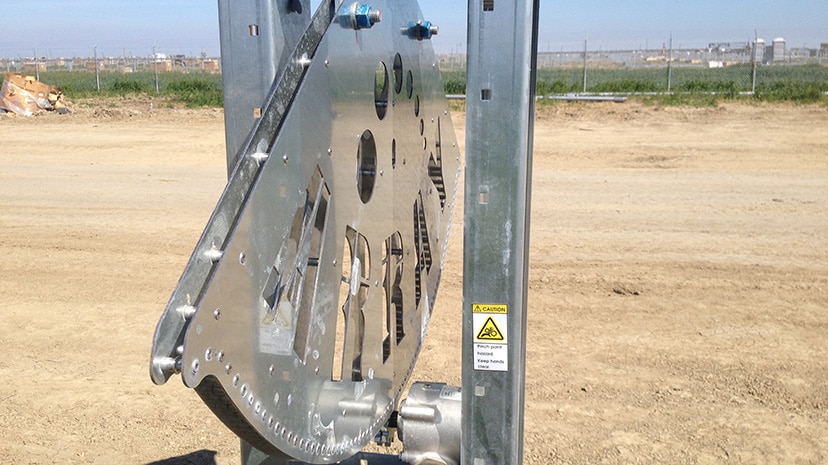Three weeks ago pv magazine held a webinar with Array Technologies, Analyzing Risk and Economic Impact of Two Solar Tracker Architectures. As often is the case during pv magazine webinars, participants asked more questions than we could reasonably get to during the time that was available.
Today we are happy to bring you answers to these additional questions, as provided by Array Technologies. Please feel free to reach out to Array directly for any additional questions at info@arraytechinc.com.
Question: In case failure of one motor in centralized trackers more power generation hampered as compared to row type tracker?
Answer: On an event-by-event basis, yes, each motor failure will result in greater power loss on a centralized system (30 rows). However, if you analyze the individual row failures, since there are 30x more motors, they will have 30x the failures, or more. However, the power reduction is equivalent to 2 rows due to prone stalled rows shading the adjacent rows. Additionally, most of the time single row failures are not fixed immediately, and may take a week or more to bother to fix. So the distributed rows will actually have 2x the power loss, or more, unless technicians are continuously deployed to fix the motors.
Question: Is it possible to share the TUV report?
Answer: Yes, please visit the link below to donwload the report: http://www.arraytechinc.com/tuv-report-findings/
Question: What discount rate is used in the NPV calculations?
Answer: 10%, but this is adjustable to any value you like in the spreadsheet. Basically, it is an inverse relationship to O&M cost, so as discount rate decreases, the centralized tracker O&M advantage increases.
Question: What type of site topography was taken into account during the analysis?
Answer: The analysis assumes a relatively normal site with a minimal amount of grading. Both architectures use the same assumptions.
Question: What was the maximum sustained wind that the centralized tracker could handle?
Answer: The Duratrack® HZ v3 design standardly is configurable up to 130 mph 3-second gust speed standard. This is different than sustained winds, roughly equivalent to 110 mph. Customized designs may be available depending on the project size & location if wind speeds are higher.
Question: How to clean modules in centralized tracker architecture? How much increases the maintenance cost?
Answer: Cleaning is highly dependent on tracker design factors like gaps and obstructions between panels, site density, tracker ROM, and average height, as well as power production requirements, location, and site-design. In this analysis, TÜV arrived at the conclusion that module washing costs were considered equivalent.
Question: How much more likely would it be for a fixed tilt array to survive a hurricane than even a well-designed and installed tracker system?
Answer: No matter whether a site is fixed or tracked, so long as site design criteria are properly considered, and the structure is analyzed and designed using safe methods, they should be equally safe. Risk factors include those included in the presentation, like ignoring critical design cases or dynamic behavior of the tracker, as well as less obvious ones like the stability of the communication system or susceptibility to hacking.
Question: I guess your piling on the motors have to quite strong as they have to assume the load for several rows, Isn’t it?
Answer: Our design uses worm gearboxes that contain all loads within each row. These are a type of mechanism that allows for mechanical advantage to be transferred in only one direction. This means that we can use them to transfer motor loads into the rows, but this cannot happen in reverse. Rows and foundations that have our motorized units attached see loads no different than any other row.
Question: Is the depth of pile embedment very different between centralized and decentralized architectures?
Answer: No, the depth of pile embedment depends on the particular tracker racking design, stowing strategy, ROM, and site requirements such as wind, seismic, and geotechnical factors.
This content is protected by copyright and may not be reused. If you want to cooperate with us and would like to reuse some of our content, please contact: editors@pv-magazine.com.









By submitting this form you agree to pv magazine using your data for the purposes of publishing your comment.
Your personal data will only be disclosed or otherwise transmitted to third parties for the purposes of spam filtering or if this is necessary for technical maintenance of the website. Any other transfer to third parties will not take place unless this is justified on the basis of applicable data protection regulations or if pv magazine is legally obliged to do so.
You may revoke this consent at any time with effect for the future, in which case your personal data will be deleted immediately. Otherwise, your data will be deleted if pv magazine has processed your request or the purpose of data storage is fulfilled.
Further information on data privacy can be found in our Data Protection Policy.